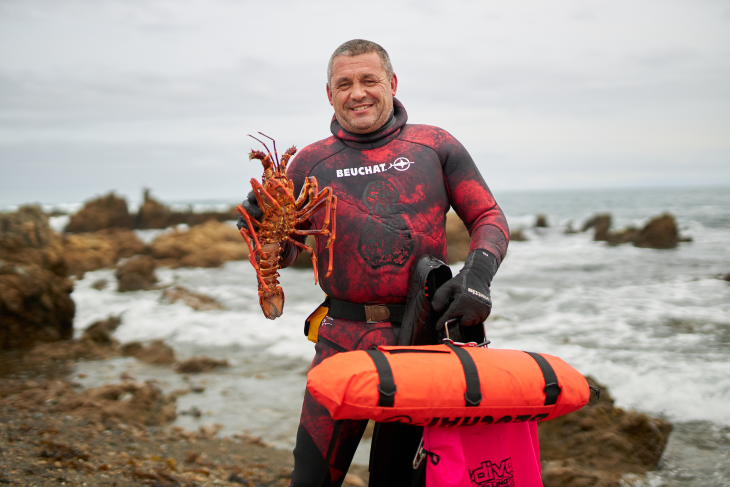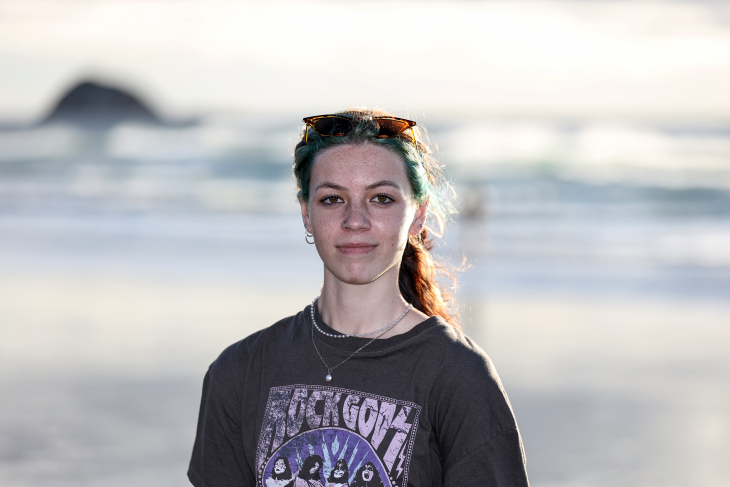Karen’s story: A mother shares her pain to help save lives Te kōrero a Karen: E whakapuaki ana tētahi māmā i tōna mamae kia ora ai ētahi atu
Video transcript for Karen's story
Audio:
Background music throughout: gentle and sombre mix of synthesiser beds, strings and piano.
Visual:
A framed photograph of Jack Skellett, a young man with long brown hair, wearing a blue woollen jersey and a backpack, smiling at the camera in front of forest and mountain scenery, sits on a table in a motorhome, as the scenery of Wellington harbour drifts by on the background.
Transcript:
VOICE OF KAREN SKELLET, JACK’S MOTHER
Jack died tragically at 23
Visual:
The screen shows a view of the road out of the front windscreen between the driver and passenger
Transcript:
and I would like that not to happen to anyone else.
Visual:
Karen Skellet sits on a couch in front a window with a garden in the background. She has shoulder length blonde hair, blue eyes and is wearing a pink top with dark flowers
Transcript:
To get used to not speaking to him every day, and this just left a huge hole that no one else can fill.
Visual:
A closeup shot of kayaker paddling towards Matiu-Somes Island
TEXT ON SCREEN: On 20 December 2021, Jack Skellett kayaked from Petone Beach to Matiu-Somes Island in Wellington.
A high drone shot looks from the Petone end of Wellington Harbour towards the city
TEXT ON SCREEN: He never came home.
Petone Wharf from a low angle, looms on the left of the screen and we see Wellington City in the far distance. It is late afternoon.
An empty van is parked looking out to sea, with an empty roof rack
Transcript:
We found out late, almost at bedtime really, his van was still parked at Petone, but there was no kayak there on the roof.
Visual:
Matiu-Somes Island can be seen between the poles and deck of Petone Wharf as the sun sets.
Matiu-Somes Island with the sun setting behind it
Karen speaks from the couch
Transcript:
I don't suppose I was that worried because he's quite resourceful. So, it wasn't until Adam said to me, “He’s paddled out to Somes Island” and I was like, wow, that's a long way to go.
Visual:
The footage of the Petone shoreline goes out of focus and we look out the front windscreen of a car, struggling to make sense of the out of focus lights and shapes coming towards us
Transcript:
There were search parties everywhere from his work, his friends, the police.
And we were walking along around Eastbourne.
Visual:
Karen speaks from the couch
Transcript:
And you just looked at the weather and the sea and just thought, yeah, this is not going to be a good outcome.
Visual:
Lower drone footage flying along the rocky shoreline of Eastbourne with cliffs rising on the left and the water the right
TEXT ON SCREEN: Jack’s body washed up near Camp Bay the following evening.
The drone flies through rain
Transcript:
Where he was found.
Visual:
Karen walks away from the camera along the rocky shoreline with her hands behind her back, looking out to the water
Transcript:
It feels, feels like that was his resting place. If there is such a thing. Where he washed up on to the beach.
And I lay with him on the beach until they came to take him to the coroner's office.
I lay there on the beach with him and held him.
Visual:
Karen speaks from the couch
Transcript:
And he just looked like he was asleep.
And I just wanted to stand him up and make him live because he didn't look like he could be dead.
Not really. It just looked like he was asleep.
Visual:
Karen stands on the shoreline on a dull afternoon, hands in pockets looking toward the sea
High drone shot of Days Bay with hills rising on the left, wharf jutting out into the harbour and the opening to Wellington Harbour in the distance
A group of teenagers jump of Days Bay wharf, with Wellington City in the background across the harbour
The camera follows Karen and her partner Mark as they walk along the shoreline with a small dog following behind
TEXT ON SCREEN: In 2022, we had 23 preventable drownings – the highest number since 2008.
ACC and Water Safety NZ are urging all New Zealanders to ‘Have a hmmm’ before they jump in.
Visual:
A pākeha man with short grey hair in a blue suit stands on the Wellington waterfront and speaks to camera
Transcript:
VOICE OF DANIEL GERRARD CEO – Water Safety NZ
It's a very difficult thing to do, but this is how we can get some messages across.
Visual:
General kayaking footage including closeups, underwater, drone
Transcript:
It's understanding what went on. Understanding that the hurt and the suffering and the pain that as a whānau and family, you experience, but trying to take the most we can out of these situations so that others don't have the same challenges.
Visual:
Karen and Mark walk with their dog onto Petone beach followed by a group of young adults. They congregate in front of Petone Wharf
TEXT ON SCREEN: Jack was passionate about the environment. Karen and his friends marked is birthday with a beach clean at Petone.
Transcript:
VOICE OF KAREN SKELLETT
Don't want Jack to be forgotten.
Got a lot of friends, his work colleagues, he’s special to a lot of people.
Him and I beach cleaned if we were together on the beach right from being, you know, a little, little boy.
It was special that they all make the effort to come.
This was where he lived.
And this is where he was lost and found.
And I want to be here for his birthday.
Visual:
A man drags a red kayak into the water
A photograph of a blue kayak with a paddle on the ground in front of it
TEXT ON SCREEN: Karen wants all New Zealanders who are buying second-hand equipment to have more information.
Transcript:
Jack’s kayak that he bought wasn't advertised that it comes with a skirt or you need a skirt.
Visual:
Karen speaks from the couch
Transcript:
It didn't say what it was for.
Now, you could have the argument that if you buy a kayak, you should know that.
But you don't know what you don't know.
Visual:
A teenager wearing a lifejacket reaches for a red kayak on the calm shores of Eastbourne. Other kayaks are on the beach and another in the water
The man in the suit from the earlier scene faces the camera
Transcript:
VOICE OF DANIEL GERRARD CEO – Water Safety NZ
Making sure you've got the right skills before you go out on a new piece of equipment.
Visual:
A woman and two children paddle a single kayak
General beach shots
Transcript:
Making sure that you're fit enough to be out there, and to make it even more fun always do it with a friend. Whether you’re diving, whether you’re fishing, whether you’re going for a kayak paddle.
You know, we just really encourage that.
Visual:
Karen Skellett arranges driftwood on the shoreline
TEXT ON SCREEN: The outpouring of love for Jack has been overwhelming.
Visual:
The pieces of wood spell the name ‘Jack’
Transcript:
VOICE OF KAREN SKELLETT
Yeah, it was heart-breaking but lovely because when you've only got one child and you're from a small family, it's lovely to know that he won't be forgotten.
I think, you know, somebody’s always going to remember him.
Audio: Gentle music
Visual:
The opening photograph of Jack Skellett with the mountains in the background
TEXT ON SCREEN: In memorium of Jack Skellett
SCREEN FADES TO BLUE
TEXT ON SCREEN: We help New Zealanders stay safe in and around the water.
We’re also here to support you if you get injured
Water Safety NZ and ACC logos
More info: www.acc.co.nz/have-a-hmmm
After tragically losing her son Jack in a kayaking trip that went wrong, Karen Skellett is urging all New Zealanders to understand the risks and stay safe in the water.
In the days leading up to Christmas two years ago, Karen Skellett received a call she would never forget.
Karen’s son Jack had recently bought a kayak off TradeMe and, on the morning of 20 December 2021, he went out for a trip from Wellington’s Petone Beach.
It's believed Jack, 23, had planned to paddle around Matiu-Somes Island. With Jack being such an active and outgoing person, Matamata-based Karen didn’t immediately fear the worst when a call to her son went unanswered that evening.
“I thought he was probably out with his mates,” Karen recalls.
“I knew he had a life jacket. I thought he would just drive it down to the beach and go somewhere along the coastline a little bit.”
The outlook changed when Jack’s van was found that night at Petone Wharf without the kayak.
Police and Coastguard started their search at that point. With Jack a beloved team member at University Recreation Wellington and a talented footballer, many joined to help as Karen and her partner travelled to Wellington.
The search focused on the area between Days Bay and Baring Head. While conditions were calm when Jack set off, the weather had turned by the time the search was underway.
In what has become an all-too-familiar ending for Kiwis who run into trouble in the water, his body was found the following evening.
“Jack’s father called me in the early hours to say they’d found the kayak and I went, ‘Oh, great’. But he said, ‘No, no, no, they found the kayak but they haven’t found Jack’. Then they found his life jacket a little bit later.
“There was a lot of searching going on by lots of people – the football club, the university and his friends.
“It was just that realisation. We were walking up and down from Eastbourne to Days Bay and it was so windy and raining, the sea was so rough you just knew he wasn’t going to be found alive. You knew it wasn’t going to be a good outcome.”
Karen believes Jack made it to Matiu-Somes Island as a person matching his description was spotted by a passing boat user.
"How Jack was found the following day would indicate to us that he had stopped to swim, possibly at one of the coves around the island. It shows the sea is treacherous, both in and out of a kayak.”
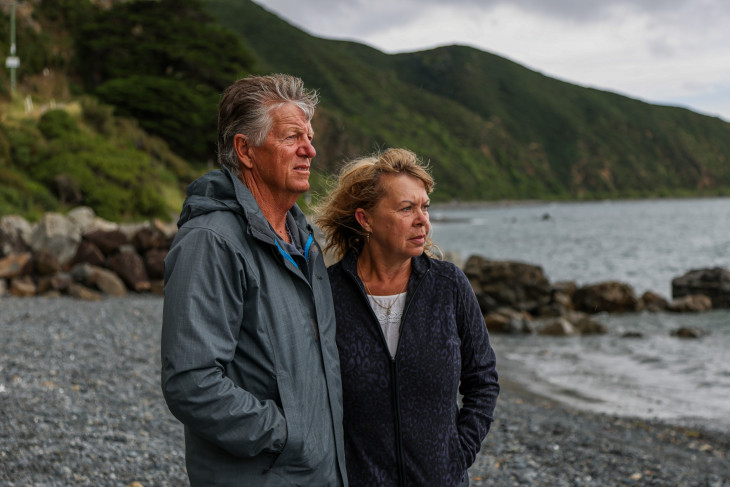 Karen Skellett with her current partner Mark Wallis
Karen Skellett with her current partner Mark Wallis'I don’t want other parents to have to go through this'
Jack’s death was part of a shocking rise in drownings over the last two years.
Ninety people drowned in 2021 – the most in a decade – according to Water Safety New Zealand.
It only got worse last year, with the provisional number of preventable drownings at 93 – the highest number since 2008 (95).
Yet people continue to underestimate the risks in the water and Karen is sharing her story in the hope others don’t have to experience her pain.
She wants to raise awareness about the dangers of getting into any water-based activity without the right training and support, particularly among young adult males who may think they're bulletproof.
Of the 90 drownings in 2021, 76 were male – 13 of whom were between the ages of 15 to 24.
“I just don’t want other parents to have to go through this. There are too many drownings,” Karen says.
“You can be intelligent and physically strong but things can still go wrong for you. And people don’t know what they don’t know. There needs to be some input into our young adults to help them, not only with water safety, but with lots of things where life can go wrong and it’s taken away from you.”
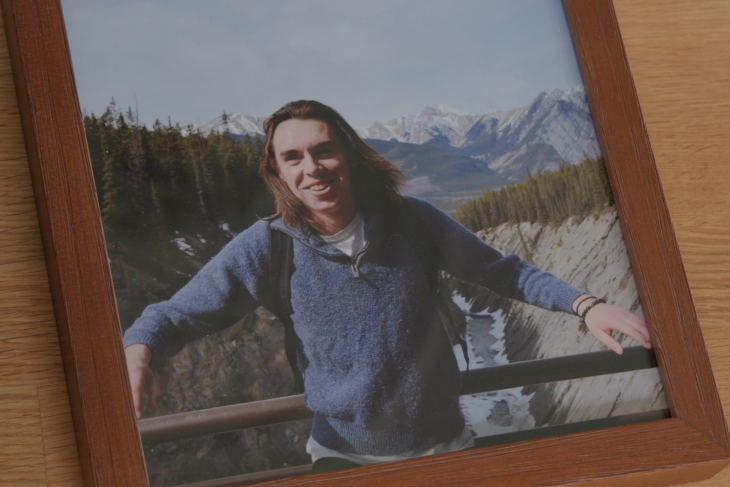
Karen's son Jack, whose life was tragically cut short at just 23
Understand the risks to stay safe
It’s not just drownings that are hurting Kiwis.
From 1 July 2021 to 30 June 2022, we received 27,583 claims for water-related injuries. That's about 76 claims a day from people out enjoying activities like surfing, swimming and kayaking.
Water sports had the highest number with 19,351 injury claims in this period, ahead of boating injuries (8,649). Males made up 64 per cent of water-related injury claims.
ACC Injury Prevention Programme Leader James Whitaker says it's the Kiwi way of life to be in and around the water, but it's an issue that needs addressing.
“Far too many of our friends and family members are drowning or getting injured in New Zealand waters - and these drownings and injuries are preventable,” James says.
“We all want to go home after a great day at the beach or out on the water, so let’s make sure we do that. People need to assess things before they go in. Don’t overestimate your ability and don’t underestimate the conditions.
“If we take the time to assess the risks before we jump in and make smart choices, we can keep doing the things we love.”
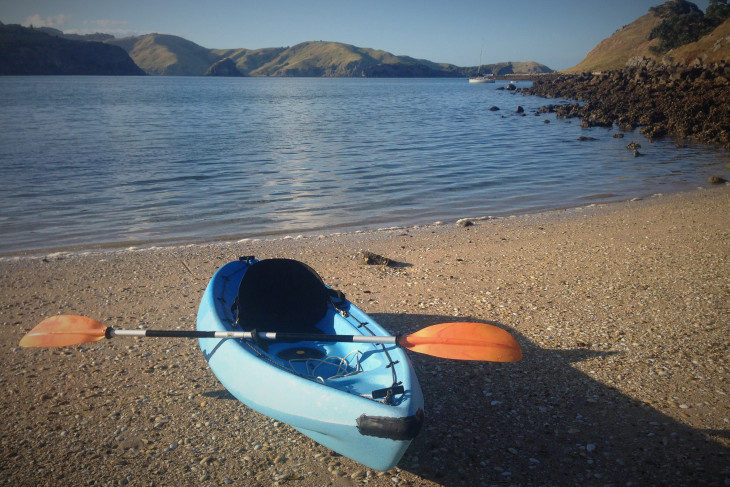
Know your limitations
Between 2012 and 2021, we received nine kayak-related fatal drowning claims. However, there were four deaths involving kayaks in 2022 recorded by Water Safety New Zealand.
When used properly kayaks are very safe, says Water Safety New Zealand chief executive Daniel Gerrard. But their limitations need to be understood and he stresses the importance of not going out alone.
“You need to have the right skills before you go out on a new piece of equipment and make sure you’re fit enough to be out there,” he says.
“Like seat belts, life jackets save lives. Always wear a buoyancy-vest or life jacket designed for kayaking.
“And to make it even more fun, always do it with a friend. We really encourage that – whether you’re diving, fishing or going for a kayak paddle.”
Daniel applauds Karen for bravely sharing her story and urges all New Zealanders to remember her message as they go about their summer.
“To see one loss of life is incredibly tragic,” Daniel says.
“We're all wanting to get out and enjoy the amazing environment we have. We just want you to stop and think about the risks.”
Water Safety NZ’s How to be Safe Kayaking
Be Safe – Be Seen
- These fun boats are common on lakes, rivers and around the coast. Used properly, they are very safe, but their limitations need to be understood.
- When kayaking in areas used by other craft, make sure you’ll be seen. A kayak can be almost invisible to skippers of other craft.
- Wearing bright clothing, having brightly-coloured paddle blades with reflector strips and displaying a very bright orange or red flag about a metre above the water on a rod will greatly reduce the chance of being run down accidentally.
- Only experienced, fit paddlers should use a kayak in rough water.
- Kayaks can easily capsize. It’s essential to have buoyancy fitted to make sure it stays level so it can be re-boarded.
- Always wear a buoyancy-vest or life jacket designed for kayaking.
- Make sure you don’t become separated from your kayak following a capsize.
- Between sunset and sunrise, a kayak must display a white light. It can be a 360º (fixed white light or a torch) but a flashing light or strobe is not acceptable (strobe lights are used to mark a man overboard). The white light should be bright enough to be seen two miles (about 4km) away. Colours other than white are not allowed.
- Get tuition at a kayaking club or with Coastguard Boating Education.
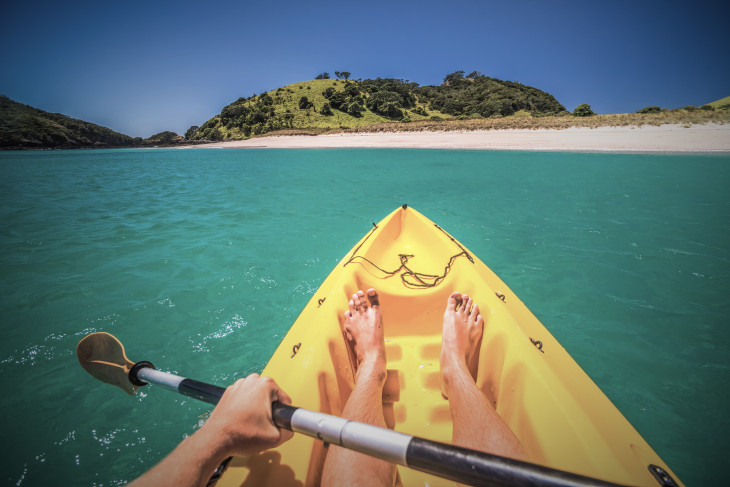
ACC Water Skills for Life
ACC partners with Water Safety New Zealand to keep children safe in and around water through the ACC Water Skills for Life programme.
Knowing how to swim is not enough. Water Skills for Life teaches other life-long water safety and survival skills so kids can have fun and keep themselves safe.




